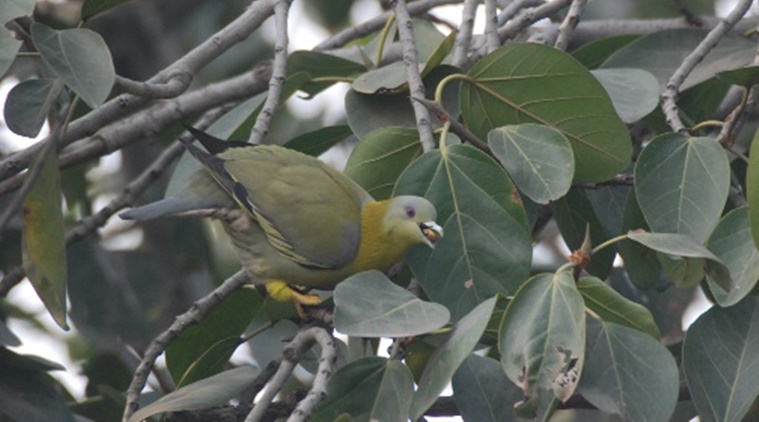 For all their sweet voices and gentle looks these so-called “frugivorous” birds are gluttons and will scoff figs and berries like there is no tomorrow.
For all their sweet voices and gentle looks these so-called “frugivorous” birds are gluttons and will scoff figs and berries like there is no tomorrow.
As I have mentioned before, people everywhere are hearing birdsong and bird calls like never before. While most of these calls could even be heard during the noisy “old” days, some were, indeed, drowned out by the racket we made. Among them had to be that of the yellow-legged green pigeon. This handsome bird, clad in olive-green, ash-grey and bright yellow (including legs) feathers suddenly seems to have come into its own — its soft whistling chuckles can now be easily picked up.
For all their sweet voices and gentle looks these so-called “frugivorous” birds are gluttons and will scoff figs and berries like there is no tomorrow. But, apparently, they’re supposed to be very tasty themselves! They know this, and, will, therefore, normally sit tight, perfectly concealed in the depths of a tree, watching you. If a single bird panics, the whole bunch of them bluster off, leaving you scratching your head in wonder.
I’ve never been very enamoured of the pigeon and dove clan: they look a bit dumb and not sparky and cheerful like most other birds. They waddle and always seem to be in the midst of a panic attack in flight. (But they can clock serious speeds and fly for hours.) Certainly, they’ve given us a lot to think about: from what our powers of extermination are to how to succeed like no bird has succeeded before. Passenger pigeons in the US literally clouded the skies and were shot until the last one died in the Cincinnati Zoo many years ago. The ubiquitous blue rock dove seems to be avenging that loss by invading every big city space in the world and is shoving all other (especially smaller) birds out of its way — with cooperation from us. Homing pigeons these days must be feeling smug: with their uncanny GPS systems, they can and will return to their roosts no matter where they’re taken! Ornithologists, in their usual befuddling way, have named one small common dove, the “laughing” dove (little brown dove or Senegal dove): Listen to it “croo-croo-doo-doo” and you’ll feel drowsy in no time.
There’s another vacant, vanilla-looking fellow called the collared dove, which, yes, wears a black collar and looks as though it’s put on far too much face powder. And believe me, these symbols of peace are aggressive: watch blue rock doves try and tear each other’s throats out and you’ll understand. I was once threatened bodily harm (crap on my feet) by a crowned Victorian pigeon in an aviary in Singapore. The clan also seems obsessed with sex — watch the way the dudes pirouette around every pigeon, lady or gent (and, sometimes, other things) they land near, throatily declaring their undying love. Yet, they’re supposed to be monogamous!
The clans by and large make hopeless nest builders. Eggs often fall through the skimpy collection of thin twigs that make up their home. Squabs become hulking louts very quickly indeed — greedy, aggressive teenagers their parents probably can’t wait to see the back of! While green pigeons seem to have come into their own these days, there are other city species that have gone quiet. Silence does speak louder than words, because it suddenly hits you hard: missing all those birds you once heard and saw and didn’t really register, let alone thought of as being special. The common babbler, with its football referee whistle, has gone and so have the large grey babblers. White wagtails and hoopoes no longer saunter on the lawns in winter, and the redstart, too, has gone AWOL.
White-eared bulbuls that once nested in the garden hedge have also vanished. On the Northern Ridge, the small kingfisher has left the ponds, and, further afield, all three varieties of shrikes — the common, the long-tailed, bay-backed and grey — have become rarities. While the black-rumped flameback still laughs maniacally from the trees, the yellow-fronted pied woodpecker has vanished. I haven’t seen the majestic crested serpent-eagle that used the Nicholson Cemetery as a transit halt every October, for many years now. Sparrows no longer nest and entertain me with their soap operas in the verandah every spring. We have practically exterminated the vultures without firing a single shot, despite their great utility to nature.
Now, with the whole world sent to Coventry, we’re beginning to hear (and see) wonders we had obliterated from our senses. Perhaps, these days of tranquillity and birdsong will make us reflect a bit about how we have treated the natural world and how well it thrives without us. So that once it’s back to business again, with blaring horns and belching fumes and turgid water, we don’t sit down one day, clutch our heads and say, “Ah, those were the days, my friend!”